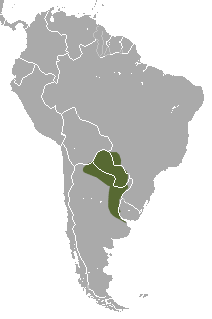Chaco narrow-pouch rat
| Chaco slim-pouch rat | ||||||||||||
|---|---|---|---|---|---|---|---|---|---|---|---|---|
| Systematics | ||||||||||||
|
||||||||||||
| Scientific name | ||||||||||||
| Cryptonanus chacoensis | ||||||||||||
| ( Tate , 1931) |
The Chaco slender- pouch rat ( Cryptonanus chacoensis ) is a species of marsupial found in northeastern and southwestern Brazil. The distribution area extends from the south of Bolivia ( Departamento Tarija ) over Paraguay and the extreme north and northeast from Argentina to Uruguay and the Brazilian states of Mato Grosso do Sul and Rio Grande do Sul . Probably a complex of various closely related species is currently listed under the name Cryptonanus chacoensis .
description
The animals reach a head trunk length of 7 to 11.4 cm, have a 9.5 to 13.6 cm long tail and reach a weight of 10 to 19 g. The tail is about 25% longer than the head and torso combined. The fur on the back and the top of the head are ocher brown, the sides of the body are slightly yellowish. The hair has gray bases. The underside is whitish or light cinnamon in color. The coat is short and silky. The tail is gray-brown in color and slightly darker on the top than on the underside. The ears are medium-sized and gray-brown. The females have nine teats but no pouch.
Habitat and way of life
The Chaco slim-pouch rat occurs in a landscape in which moist grasslands alternate with small forests like a mosaic. The species lives mainly on the ground and seems to prefer open and moist habitats. In Paraguay the animals were also caught in small forests and in Argentina in gallery forests and plantations. The Chaco slim-pouch rat is nocturnal and spends the day in nests, which can also be in tree hollows up to 1.5 m above the ground. So far nothing is known about the diet of wild animals. One in human care ate minced meat and grapes . Little is known about reproduction either. Although the females only have nine teats, twelve young animals were counted.
The IUCN estimates the population of the Chaco slim-pouch rat as safe. Its range is wide and it is common.
Systematics
The Chaco slender-pouch rat was first scientifically described in 1931 by the American zoologist George Henry Hamilton Tate under the scientific name Marmosa chacoensis . In 1989 it was assigned to the genus Gracilinanus and in 2005 it came to this genus with the introduction of the genus Cryptonanus .
Cryptonanus ignitus (German red-bellied narrow-pouch rat), a slender-pouch rat species described in 2002, which was only known by its holotype and which was thought to be extinct, since the holotype was found in a forest area that was extensively destroyed for the cultivation of sugar cane. After a renewed investigation of the holotype, published in April 2019, proved to be the synonym description of Cryptonanus chacoensis .
supporting documents
- ↑ a b c d Diego Astúa: Family Didelphidae (Opossums). in Don E. Wilson , Russell A. Mittermeier : Handbook of the Mammals of the World - Volume 5. Monotremes and Marsupials. Lynx Editions, 2015, ISBN 978-84-96553-99-6 . Page 169.
- ^ Tate, GHH (1931). Brief diagnoses of twenty-six apparently new forms of Marmosa (Marsupialia) from South America. American Museum Novitates. 493: 1-14.
- ^ Voss, RS, Lunde, DP and Jansa, SA 2005. On the contents of Gracilinanus Gardner & Creighton, 1989, with the description of a previously unrecognized clade of small didelphid marsupials. American Museum Novitates 3482: 1-34.
- ↑ MM Díaz, DA Flores & RM Barquez: A New Species Of Gracile Mouse Opossum (Didelphimorphia: Didelphidae), From Argentina . Journal of Mammalogy 83 (3): 824-833 (2002) doi : 10.1644 / 1545-1542 (2002) 083 <0824: ANSOGM> 2.0.CO; 2
